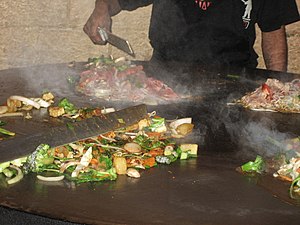Mongolian barbecue

Mongolian barbecue (Chinese: 蒙古烤肉; pinyin: Měnggǔ kǎoròu) is a stir fried dish that was developed in Taiwanese restaurants in the 1970s.[1] Meat and vegetables are cooked on large, round, solid iron griddles at temperatures of up to 300 °C (572 °F). Despite its name, the cuisine is not Mongolian, and is only very loosely related to barbecue.[2][3][4][5]
Origins
Although Mongolian barbecue first appeared in Taipei in 1951,[1] the stir-frying of meats on a large, open surface is supposed to evoke Mongolian foods and Mongolian traditions. The preparation can also derive from Japanese-style teppanyaki, which was popular in Taiwan at the time. The very first Mongolian Barbecue restaurant (Genghis Khan Mongolian BBQ) was opened in 1976, and was located in downtown Taipei, Taiwan. As Mongolian Barbecue became more popular, it was successfully introduced to the West.
American restaurants, such as HuHot Mongolian Grill and BD's Mongolian Grill, claim that soldiers of the Mongol Empire gathered large quantities of meats, prepared them with their swords and cooked them on their overturned shields over a large fire.[6][7] A German restaurant chain with the same concept claims that the Mongolian soldiers cooked their meals on a heated stone.[8]

Preparation
Typically, diners choose various ingredients from a display of thinly sliced raw meats (beef, pork, lamb, turkey, chicken, shrimp) and vegetables (cabbage, tofu, sliced onion, cilantro, broccoli, and mushrooms, pineapple, lychee), and put them in a bowl or on a plate. These ingredients are given to the griddle operator who adds the diner's choice of sauce and transfers them to one section of the hot griddle. Oil and sometimes water may be added to ease cooking, and the ingredients are stirred occasionally.
The ample size of the Mongolian barbecue griddle allows for several diners' food to be cooked simultaneously on different parts of the griddle. Each dish will be stirred in its turn, as the operator walks around the outside of the grill and turns each individual diner's food in succession. When cooking is complete, each finished dish is scooped into a bowl and handed to the diner. Many Mongolian barbecue restaurants feature an "all-you-can-eat" buffet format.
Restaurants

In Taiwan, a number of restaurants exist that specialize in Mongolian barbecue with additional buffet items available as well. These establishments often have names evoking the Mongol Empire such as Great Khan (大可汗) or Temüjin (鐵木真). The peak popularity of these restaurants was in the 1980s and 1990s.
In the United States, Mongolian barbecue is often found in American Chinese buffet restaurants, but some businesses focus primarily on the barbecue such as HuHot Mongolian Grill, BD's Mongolian BBQ and Genghis Grill.
Jingisukan

In Japan, a similar dish to Mongolian barbecue called Jingisukan (ジンギスカン, "Genghis Khan") (Mongolian: Chinggis Khaan "Чингис Хаан") is prepared with mutton and cooked on a convex metal skillet. The dish is particularly popular on the northern island of Hokkaidō. The dish is rumored to be so named because in prewar Japan, lamb was widely thought to be the meat of choice among Mongolian soldiers, and the dome-shaped skillet is meant to represent the soldier's helmets that they purportedly used to cook their food.
See also
- Mongolian cuisine
- Khorkhog, Another dish referred to as "Mongolian barbecue".
- Korean BBQ, galbi refers to a variety of grilled dishes in Korean cuisine.
- Bulgogi, popular Korean stir-fried grill, similar to Mongolian barbecue.
- Saj, a convex griddle used in central, south, and west Asia for cooking bread and meat
- Teppanyaki, a similar Japanese style of cooking
- Barbecue restaurant
- brochette, a French style of barbecue.
Notes
- ^ a b 吳兆南》相聲大師:蒙古烤肉我創的喔
- ^ "AT THE NATION'S TABLE; Appleton, Wis.," The New York Times
- ^ Davison, Gary Marvin, Barbara Reed. Culture and Customs of Taiwan. 144.
"Also very popular and superbly developed by Fujianese cooks is Mongolian barbecue..." - ^ Schwabe, Calvin W. Unmentionable Cuisine. [1].
- ^ Cismar, Martin. "Barbecuing, The Mongolian Way", Daily News-Record
- ^ "History" at BD's Mongolian Grill website. Accessed May 1, 2007. Template:En icon
- ^ "蒙古烤肉" at MTour (呼伦贝尔旅行网). Accessed May 1, 2007. Template:Zh icon
- ^ "Idee" at Mongo's Restaurants' website. Accessed November 25, 2007. Template:De icon


